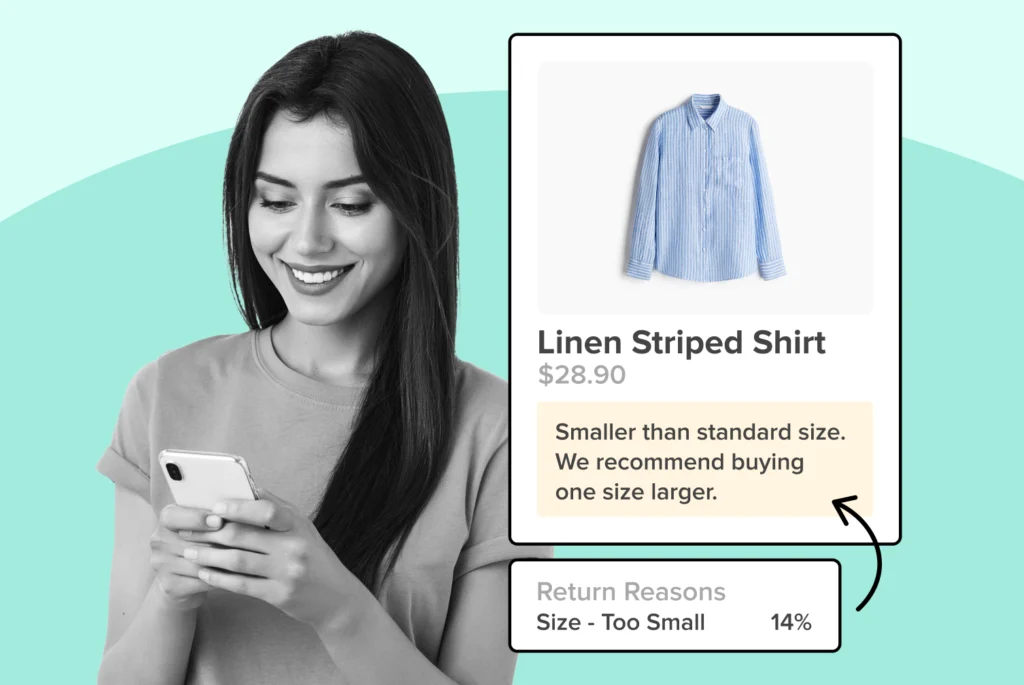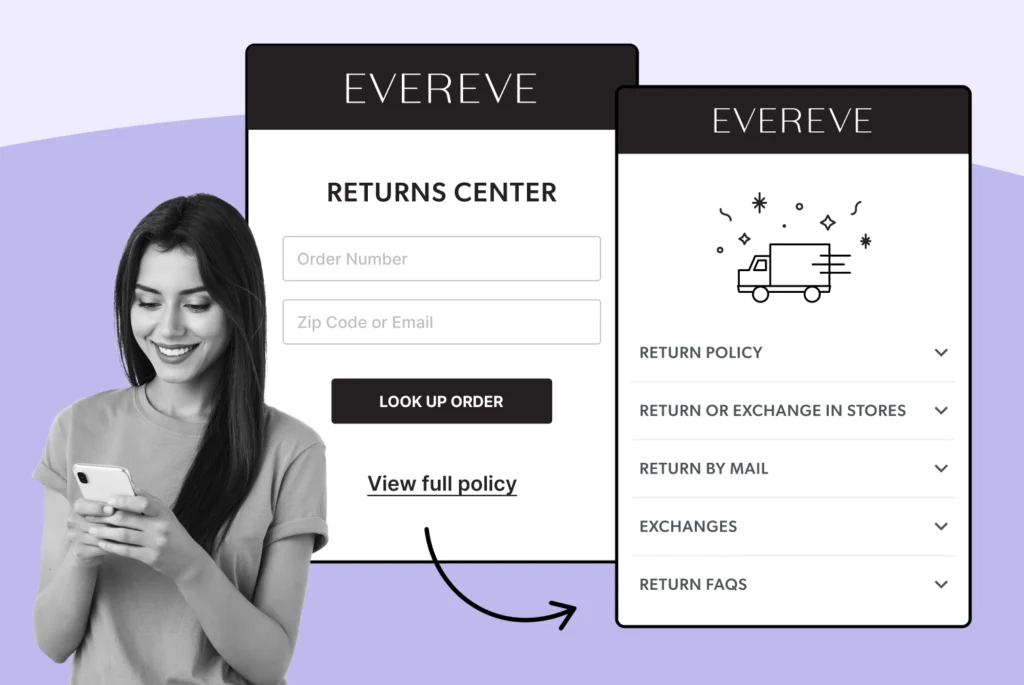
Should You Require Comments in Your Shopify Return Policy?
Explore the legal aspects of return policies and whether they constitute a legal agreement. Learn how this impacts your shopping experience. Read more.
Shipping, Tracking & Notifications
Boost customer experience and reduce support tickets
Realtime order and shipment tracking
Proactive order and shipping notifications
AI-Enhanced Discounted Labels
Predictive pre-purchase estimated delivery dates
Self-Serivce branded order tracking
Effortless experience delivered
Identify and Resolve Order Issues
Realtime order and shipment tracking
Make returns profitable and delight customers
Flexibility to define any return destinations & conditions
Simplify returns for your customers and team
Incentivize exchanges over returns
Returns management made easy for your team
Returns management made easy for your team
Easy claims and smart upsells
Understand why your customers are returning
In-Store & Curbside Pickup
Unify the online and the in-store experience
Hassle-free pickup experience for customers
In-Store dashboard to keep operations streamlined
In-Store and Online orders unified
Drive foot-traffic to your stores
Shipping, Tracking & Notifications
Boost customer experience and reduce support tickets
Realtime order and shipment tracking
Proactive order and shipping notifications
AI-Enhanced Discounted Labels
Predictive pre-purchase estimated delivery dates
Self-Serivce branded order tracking
Effortless experience delivered
Identify and Resolve Order Issues
Realtime order and shipment tracking
Make returns profitable and delight customers
Flexibility to define any return destinations & conditions
Simplify returns for your customers and team
Incentivize exchanges over returns
Returns management made easy for your team
Returns management made easy for your team
Understand why your customers are returning
In-Store & Curbside Pickup
Unify the online and the in-store experience
Hassle-free pickup experience for customers
In-Store Dashboard to keep operations streamlined
In-Store and Online orders unified
Drive foot-traffic to your stores
Boost customer experience and reduce support tickets
Realtime order and shipment tracking
Proactive order and shipping notifications
AI-Enhanced Discounted Labels
Predictive pre-purchase estimated delivery dates
Self-Serivce branded order tracking
Effortless experience delivered
Make returns profitable and delight customers
Flexibility to define any return destinations & conditions
Simplify returns for your customers and team
Incentivize exchanges over returns
Returns management made easy for your team
Equip your team for precise return checks.
Easy claims and smart upsells
Understand why your customers are returning
Unify the online and the in-store experience
Hassle-free pickup experience for customers
In-Store Dashboard to keep operations streamlined
In-Store and Online orders unified
Drive foot-traffic to your stores
Find the answer to all your questions
Take a step by step trip through our functionality to see how we can improve your ecommerce processes.
Explore the most comon questions about WeSupply
Calculate the ROI that WeSupply can bring you
Request a no strings attached review of your current shopping experience and missed conversion opportunities
Read actionable articles on how to optimize your post-purchase experience and decrease support tickets
Get inspired by stories of how our customers implemented an effortless post-purchase experience
Wondering if WeSupply is a good fit for you? Read through our use cases to see how we can help you increase conversion & improve CX!
A Deep Dive into Top Companies' Order Tracking & Returns Strategy
Find the answer to all your questions
Explore the most comon questions about WeSupply
Calculate the ROI that WeSupply can bring you
Request a no strings attached review of your current shopping experience and missed conversion opportunities
Take a step by step trip through our functionality to see how we can improve your ecommerce processes.
Read actionable articles on how to optimize your post-purchase experience and decrease support tickets
Get inspired by stories of how our customers implemented an effortless post-purchase experience
A Deep Dive into Top Companies' Order Tracking & Returns Strategy
Wondering if WeSupply is a good fit for you? Read through our use cases to see how we can help you increase conversion & improve CX!

Wondering if a 30-day return window is right for your business? This article weighs the pros and cons, specifically focusing on the “30 day return window weighing the pros and cons,” examining how it can boost customer satisfaction while posing challenges to operations. We’ll help you understand both sides to make an informed decision.
A 30-day return window enhances customer satisfaction and loyalty by providing flexibility, minimizing buyer’s remorse, and fostering trust in purchase decisions.
While beneficial, a generous return policy can increase operational costs, complicate inventory management, and pose risks of return fraud, necessitating careful policy management.
Effective strategies, such as clear communication, restocking fees, and leveraging returns as a marketing tool, can help businesses balance customer care with cost control.
The 30-day return window is a hallmark of modern eCommerce, providing a safety net for customers and fostering confidence in their purchases. This period allows customers to evaluate their products, ensuring satisfaction and reducing buyer’s remorse. But why 30 days? Historically, this timeframe has been widely adopted in retail due to its balance between customer convenience and operational feasibility.
Striking a balance between customer satisfaction and business interests is crucial. A 30-day return policy offers flexibility to customers while allowing businesses to maintain manageable return rates and operational efficiency. This foundational understanding sets the stage for a deeper exploration of its advantages and drawbacks.
Every eCommerce business needs a clear return and refund policy to avoid confusion and frustration. When expectations are set clearly, it builds trust and improves the shopping experience. However, some businesses may implement no refund policies that could affect customer satisfaction.
Transparent refund policies manage customer expectations and create a sense of security. Clear communication prevents misunderstandings and reduces disputes. Valuing relationships while protecting the business creates a positive customer experience.
A straightforward return policy significantly impacts customer satisfaction. Addressing concerns promptly and fairly enhances brand perception, leading to increased loyalty and repeat business.
The 30-day return window offers numerous benefits that can enhance customer satisfaction, boost sales, and provide valuable insights for businesses. This generous return policy fosters long-term customer relationships, encourages purchases, aligns with industry standards, minimizes buyer’s remorse, and provides critical product feedback.
A 30-day return window significantly enhances consumer confidence and fosters long-term relationships. When customers know they have the flexibility to return products, it builds trust and makes them feel valued. This trust translates into increased customer satisfaction and loyalty, as customers are more likely to return for future purchases.
A generous return policy enhances customer trust and leads to a more positive shopping experience. Allowing customers to evaluate their purchases thoroughly creates a sense of security and appreciation, further solidifying the customer base.
Knowing that returns are possible within 30 days can lead to higher conversion rates. Online shoppers are more likely to complete their purchases when they know they have the option to return items if they are not satisfied. This assurance encourages customers to explore a wider range of products in the online store and make purchases they might otherwise hesitate to complete.
A 30-day store’s return policy can prompt customers to try more products, increasing their overall spending. The peace of mind from a flexible return policy encourages a more adventurous shopping experience, benefiting both the customer and the business.
Offering a 30-day return policy positions a business to stay competitive and meet customer expectations. In many industries, this policy has become the standard, and customers expect it when making online purchases. By aligning with these expectations, businesses can enhance their market position against competitors.
Industries like fashion and electronics benefit from the 30-day return standard, where the ability to return items is crucial. Implementing this policy helps businesses meet consumer expectations, ensuring they remain relevant and competitive.
The psychological effect of a 30-day return window on purchasing decisions cannot be understated. Knowing they can return items within this period bolsters buyer confidence, leading to more thoughtful purchasing decisions and decreased feelings of regret. This policy allows customers to evaluate their purchases, reducing the stress and anxiety associated with impulse buying.
Offering a 30-day return period alleviates feelings of regret and stress, enhancing customer satisfaction and loyalty. This flexibility leads to a more positive shopping experience, encouraging repeat business.
Returns provide critical data on product quality and customer preferences. By analyzing returned items, businesses can gain insights into what works and what doesn’t, allowing them to make informed improvements to their products and marketing strategies. This feedback loop can lead to better future offerings and increased customer satisfaction.
Using returns to improve products and refine marketing strategies enhances a business’s ability to meet customer needs and preferences. This feedback helps businesses stay competitive and relevant in a constantly evolving market.
While the 30-day return window offers numerous benefits, it also presents several challenges for businesses. Increased return rates can strain operational resources, lead to higher costs, and complicate inventory management.
The financial impact, risks of return fraud, inventory challenges, and environmental consequences are important considerations when implementing a generous return policy.
Handling returns can significantly increase operational costs. The process of restocking, processing, and shipping returned items requires substantial logistical support and labor. The average cost of processing returns can reach up to $100 per item, factoring in labor, shipping, and the item’s purchase price.
The strain on customer service teams and logistical operations can be considerable. Efficient resource allocation to manage returns is necessary, impacting profitability and overall operational efficiency.
Return fraud, such as “wardrobing” (buying and returning used items), poses a significant risk to profitability. Certain customers may exploit return policies, leading to financial losses for businesses. Returns fraud leads to significant annual losses estimated at $90 billion for U.S. retailers.
Businesses can mitigate fraud by implementing policies like restocking fees. These measures deter frivolous returns and help recover some handling costs, protecting the business’s bottom line.
Returns within a 30-day window can disrupt inventory tracking and management. The influx of returns creates discrepancies in inventory levels, complicating stock management and potentially leading to additional costs for restocking unsellable items.
Restocking and reselling returned items, especially seasonal or perishable goods, present challenges. Efficient handling of returned items is crucial for effective inventory management and maintaining accurate stock levels.
Higher return rates contribute to increased carbon emissions from logistics operations. The environmental consequences of transporting returned items can be significant, particularly when unsold returned products end up in landfills. This environmental impact is a major factor that businesses need to consider when implementing a generous return policy.
Reducing environmental impact is possible through smarter returns strategies. By optimizing logistics, encouraging responsible returns, and implementing sustainable practices, companies can minimize the carbon footprint of returns.
While a 30-day return policy is standard in e-commerce, it can lead to increased operational costs, potential return fraud, inventory management complexities, and environmental concerns. WeSupply offers solutions to address these challenges effectively:
Return Fraud Prevention: Identifies and blocks policy abusers by detecting patterns of return abuse, such as one-time-use returns or habitual exploiters.
Efficient Inventory Restocking: Accelerates the restocking process during returns, minimizing the impact on stock levels and ensuring product availability.
Sustainable Return Options: Implements “Green Returns,” allowing customers to keep low-cost items while still receiving a refund or exchange, reducing shipping and landfill waste.
By leveraging WeSupply’s comprehensive returns management solutions, businesses can mitigate the drawbacks of a 30-day return window, enhancing operational efficiency, reducing costs, and promoting sustainability.
Effective management of the 30-day return window can significantly enhance customer satisfaction while optimizing operational costs.
Strategies to balance generosity with operational needs include implementing restocking fees and encouraging store credit over cash refunds.
A lenient return policy can lead to increased sales, but it may also expose businesses to potential return abuse. Balancing a customer-friendly return policy with business considerations like profitability and inventory management is essential. Examples of businesses that successfully balance customer satisfaction and cost control can provide valuable insights.
Overly lenient return policies may lead to financial strain, making balance essential. Carefully crafted return policies protect the bottom line while maintaining customer satisfaction.
Restocking fees can help mitigate the cost of returns and deter frivolous returns. These fees serve as a financial deterrent against non-serious returns, helping to offset the costs incurred by businesses. Best practices for implementing restocking fees without alienating customers include clear communication and reasonable fee structures.
Implementing restocking fees encourages responsible returns and helps recover operational costs, ultimately protecting profitability.
Offering store credit instead of cash refunds can benefit both businesses and customers in store. Store credit can help retain revenue while encouraging future purchases, improving overall revenue retention. This approach can also improve customer loyalty and drive repeat purchases.
Offering store credit motivates customers to make future purchases, enhancing engagement and satisfaction. This strategy maintains cash flow and builds long-term customer relationships.
WeSupply helps businesses optimize their 30-day return policy by offering flexible, customer-friendly solutions that balance profitability with customer satisfaction. Key features include:
Charge Restocking Fees for Specific Products: Apply fees selectively to manage return costs without sacrificing customer service.
Incentivize Exchanges Over Returns: Encourage customers to choose exchanges by offering instant store credit, redirecting them back to your product catalog to boost average order value.
Refund to Store Credit, Gift Card, or Coupon Code: Automatically issue refunds as store credit, gift cards, or coupon codes, promoting future purchases while building customer loyalty.
With WeSupply, managing the 30-day return window becomes efficient and profitable, allowing you to maintain a flexible, customer-centric approach.
Exploring alternatives to the 30-day return window can provide businesses with additional options to manage returns effectively.
Exploring shorter return windows, extended holiday return periods, and no return policies for final sale items offers businesses additional options to manage returns effectively.
Simplify Returns for Your Customers and Support Team
Book a quick call with our experts to see how WeSupply can help you: simplify the Return experience with just a few clicks, reduce customer service calls and manual processing, notify your customer about their refund, automate returns and reduce user error.
A 14-day return window can be effective in reducing return rates and improving operational efficiency. Research indicates that a significant majority of returns occur within the first two weeks after purchase, making a shorter return period appropriate in many cases. Setting a 14-day return window can encourage quicker purchasing decisions and decrease return rates.
Different return periods for exchanges and refunds enhance customer relationships and manage returns effectively. This approach allows businesses to tailor policies to their needs and customer expectations.
Extending return windows during the holiday shopping season can boost sales and enhance customer loyalty. Special return policies during peak seasons can alleviate customer concerns and enhance the shopping experience. Offering longer return windows during holidays can significantly enhance customer loyalty and increase sales.
Holiday-specific return policies manage increased return volumes effectively and foster greater customer loyalty. This approach leads to a more positive shopping experience and encourages repeat business.
Enforcing no-return policies for final sale or heavily discounted items can safeguard profits. Restricting returns on final sale items helps maintain profit margins by reducing the risk of returns on heavily discounted products. Communicating no-return policies effectively is crucial to manage customer expectations and reduce dissatisfaction.
Communicating no-return policies clearly prevents customer dissatisfaction and ensures a positive shopping experience. Implementing these policies on final sale items protects margins during discount sales.
WeSupply empowers businesses to move beyond the standard 30-day return window by offering flexible, customer-centric alternatives. These tailored approaches maintain control over the return process while enhancing customer satisfaction and loyalty. Samples of WeSupply’s Pre-built Policies:
Extended Holiday Return Window: Offer longer return periods during holidays to accommodate customers, boosting seasonal sales and spreading returns into the new year for better financial management.
Extended Free Returns for VIP Customers: Enhance customer loyalty by integrating extended, hassle-free returns for VIPs into your CRM and loyalty programs, boosting customer lifetime value and reducing churn.
By offering these flexible return options, WeSupply helps businesses maintain profitability, strengthen customer relationships, and stay competitive in the evolving retail landscape. Looking for more ideas? Check out our other pre-built return policies to find the perfect fit for your business!
A robust returns management process is essential for maintaining customer loyalty and satisfaction. Best practices include streamlining the returns process with prepaid shipping labels, investing in returns management software, clear communication, and leveraging returns as a marketing tool.
Providing a prepaid shipping label for return shipping simplifies the process for customers and encourages return completion. Customers prefer straightforward, low-cost processes, enhancing their overall shopping experience. Prepaid labels facilitate quick returns processing, eliminating address errors and enhancing convenience, although customers may need to pay return shipping in certain cases.
Removing barriers for customers significantly impacts satisfaction and return rates. Businesses achieve higher return completion rates and improve overall return process efficiency.
WeSupply makes this process even smoother with efficient, customer-friendly prepaid shipping labels. Key features include:
Printerless Returns via QR Code: Enhance the customer experience with QR code-based returns, eliminating the need for a printer. Customers can drop off their items at eligible FedEx Office, Walgreens, or USPS locations.
Specialized software can automate the returns process, reduce human error, and improve efficiency. Utilizing returns management software can significantly cut down on the administrative burden associated with processing returns. Effective software solutions can help analyze return data, providing insights into trends and common issues that lead to returns.
WeSupply’s returns management software takes this a step further by saving your team up to 80% of the time spent on returns. It streamlines the entire process, helping reduce fraud and human error while enhancing efficiency. Key features include:
Successful returns management systems, like WeSupply, help businesses scale, improve processing times, and enhance the customer experience, ultimately leading to a better overall process for both your team and customers.
Combat inconvenience with proactivity & self service
Book a quick call with our experts to see how WeSupply can help you make returns easy for your customers with a beautiful, self-service solution that makes their experience easier while also providing new ways to lower costs and earn back revenue.
Keeping customers informed throughout the return process with timely updates and clear policies fosters trust and prevents misunderstandings. Transparent return policies can greatly reduce customer frustration and uncertainty during the return process. Providing consistent updates throughout the return process helps maintain customer trust and encourages repeat business.
WeSupply enhances customer satisfaction by providing clear communication and transparency at every stage of the return journey. With automated return item tracking and proactive notifications, you can address customer inquiries before they even need to reach out. Key features include:
Returns Shipment and Process Tracking: Track the return journey of each item, providing customers with real-time updates on where their returned products are in the process.
Fully Customizable Branded Notifications: Personalize return notifications with your branding to provide a consistent, professional experience for your customers.
Proactively Reduce “Where is My Refund?” (WISMR) Questions: Preemptively answer common questions about refund status by providing customers with updates on their return and refund timelines.
Return Status Notifications: Automatically inform customers when their return is processed, when it reaches your warehouse, and when a refund is issued.
Return Delivery Confirmation: Notify customers when their returned item has been delivered to your facility, offering peace of mind that their return is complete.
Providing clear return policies and regular updates strengthens customer trust and enhances the return experience. Transparency is key to maintaining customer satisfaction and loyalty, and WeSupply ensures that customers are informed every step of the way.
Flexible return policies can be marketed as a unique selling point, attracting customers and enhancing brand image. By transforming return experiences into moments of positive engagement, businesses can increase customer loyalty and brand reputation. Flexible return policies can serve as a marketing advantage, attracting customers who prioritize ease of returns.
Turning returns into positive experiences generates goodwill and enhances brand perception. Leveraging returns as a marketing tool creates a competitive advantage and fosters long-term customer relationships.
WeSupply transforms returns into a strategic opportunity to boost customer engagement and increase sales. By leveraging proactive notifications, personalized offers, and seamless in-store returns, you can turn a potential loss into a marketing win. Key features include:
Proactive Return Notifications: Keep customers informed with post-purchase email and SMS updates, offering personalized deals to encourage repeat business.
Custom and Personalized Offers: Send tailored promotions via email and SMS to maintain customer interest and loyalty.
Buy Online, Return In-Store (BORIS): Encourage in-store visits and boost sales by allowing online purchases to be returned at physical locations.
WeSupply & Justuno App Integration: Enhance post-purchase engagement with targeted pop-ups and banners directly on the order tracking page.
Smart Product Recommendations: Use customer data to upsell higher-priced items, cross-sell complementary products, and highlight best-sellers.
By turning returns into marketing opportunities, WeSupply helps businesses build customer loyalty, increase sales, and improve the overall shopping experience, creating a competitive edge through positive return interactions.
Companies that successfully implemented flexible return policies often report increased customer loyalty and higher conversion rates.
Success stories and lessons learned from businesses that have effectively managed their return strategies provide valuable insights.
Success stories and lessons learned from businesses that have effectively managed their return strategies provide valuable insights.
Case studies show how a 30-day return policy leads to positive outcomes, including increased customer loyalty and higher conversion rates.
When COVID-19 shifted consumer behavior to online shopping, EVEREVE faced a surge in returns, especially in the fashion industry where return rates can soar up to 50%. Their manual, fragmented returns process led to inefficiencies, data gaps, and a heavy load on customer service.
The Solution:
By integrating WeSupply’s automated returns management via Magento & Custom API (Zendesk, Celerant, Veeqo), EVEREVE transformed their approach, focusing on proactivity, self-service, and return flexibility. This streamlined their operations, saved costs, and enhanced customer satisfaction by empowering users to manage their own returns.
Big Wins:
Significant cost savings and reduced support tickets.
A unified system fostering accountability and transparency.
Enhanced customer experience with proactive issue resolution and self-service options.
The Bottom Line:
By leveraging WeSupply’s technology, EVEREVE not only streamlined their returns but also turned them into customer loyalty opportunities.
The 30-day return window offers significant benefits in customer satisfaction, sales, and valuable feedback, but also presents challenges like increased operational costs and potential for fraud.
Aligning return policies with business goals, customer expectations, and operational capacity is crucial. Each business must consider its unique needs and customer base to determine the most effective return window.
Businesses can customize return policies to balance customer satisfaction with operational efficiency, ensuring a positive shopping experience while protecting their bottom line.
The 30-day return window is a standard practice in eCommerce, offering customer flexibility and boosting satisfaction. However, it can also increase operational costs, risk return fraud, complicate inventory management, and impact the environment. Balancing the benefits and challenges of this policy requires strategic management.
WeSupply helps businesses optimize the 30-day return window with features like Automated Returns Management, reducing manual effort by up to 80%, and Return Fraud Prevention, identifying habitual policy abusers. Its Efficient Inventory Restocking speeds up the return process, minimizing stock disruptions, while Sustainable Return Options like “Green Returns” cut down on carbon emissions.
WeSupply also enables flexible policy management with Custom Return Rules, Restocking Fees, and Store Credit Incentives, helping businesses maintain profitability while offering customer-friendly solutions. Additionally, Prepaid Shipping Labels and Proactive Communication streamline the return process, enhancing customer experience.
By leveraging WeSupply’s comprehensive solutions, businesses can effectively manage return policies, balance customer satisfaction with cost control, and gain a competitive edge. Get started with WeSupply today and streamline your returns process while boosting customer satisfaction and profitability!
A 30-day return window is commonly adopted in retail as it effectively balances customer convenience and operational efficiency, enabling consumers to assess their purchases while keeping return rates manageable.
Clear return and refund policies enhance customer satisfaction and loyalty by managing expectations and building trust. This transparency reduces confusion and frustration, fostering a positive relationship with customers.
Handling returns can substantially raise operational costs, averaging up to $100 per item for logistics and labor. This financial impact is crucial to consider in return management strategies.
WeSupply’s Automated Returns Management system streamlines the entire returns process, cutting down manual tasks by up to 80%. This helps businesses process returns quickly and efficiently, saving time and reducing operational strain.
Yes! WeSupply’s Return Fraud Prevention feature identifies and blocks return abuse, such as one-time-use returns or frequent returners, helping to protect your business from financial losses and maintain the integrity of your return policy.
Absolutely! WeSupply allows you to customize return rules, including restocking fees, store credit incentives, and different policies for various products. This flexibility ensures your return policies align with your business needs while maintaining customer satisfaction.
Yes, WeSupply has an official BigCommerce App. You can integrate WeSupply with your BigCommerce store to improve your post-purchase customer experience.

Learn How To Create Successful Post Purchase Email Campaigns
Build an effective post-purchase email flow that helps you increase customer satisfaction and drive revenue growth!

Explore the legal aspects of return policies and whether they constitute a legal agreement. Learn how this impacts your shopping experience. Read more.

Discover why including Shopify returns labels in the box can be a costly mistake. Six compelling reasons to reconsider this practice!

Learn how to optimize packaging for hassle-free returns and exchanges. Enhance customer satisfaction and streamline your process. Read the guide now!

Learn effective communication strategies to improve sizing accuracy and reduce returns. Discover practical tips to enhance your online shopping experience.

Explore the legal aspects of return policies and whether they constitute a legal agreement. Learn how this impacts your shopping experience. Read more.

Discover 5 effective strategies to enhance your product photos and minimize returns. Improve customer satisfaction and boost sales—read the article now!

Learn how to optimize packaging for hassle-free returns and exchanges. Enhance customer satisfaction and streamline your process. Read the guide now!

Discover effective strategies to reduce shipping delays and enhance your logistics. Improve efficiency and keep your operations running smoothly. Read more!

Discover the key traits that define today’s influencers and how they shape marketing strategies. Enhance your influencer approach!